Samsung Galaxy Note 8.0 Review
by Anand Lal Shimpi on April 17, 2013 11:29 PM EST- Posted in
- Tablets
- Samsung
- Android
- Mobile
- Galaxy Note 8.0
The Display
The Note 8.0 holds a slight pixel density advantage over the iPad mini (189 ppi vs. 163 ppi). Just like the earliest Android tablets that held a similar pixel density advantage (~13%), the improvement is noticeable. At the price point and device size however, the Note 8.0 remains under-specced. Just as the iPad mini would benefit from a Retina class display, the Galaxy Note 8.0 could use a 1080p panel as well. Given we're seeing flagship ~5" Android smartphones ship with 1080p displays, a flagship 8" tablet should meet the same criteria.
Unfortunately one of the hallmarks of TouchWiz is that all icons and widgets are considerably larger than they are under iOS, which results in a lot of wasted space on the 8-inch 1280 x 800 display. Despite having a larger display, higher resolution and higher pixel density, I feel more cramped on the Galaxy Note 8.0 than I do on the iPad mini. I understand this is a conscious design decision by Samsung and I can definitely see larger icons, fonts and touch targets resonating very well with certain demographics, but at the same time I believe the design decision flies in the face of what Samsung is hoping to accomplish with the Note family.
The Note 8.0 can get very bright, but black levels suffer as a result. Overall contrast ratio is a bit better than the iPad mini, but I'd prefer better black levels to absurdly high white levels. The latter can help improve readability outdoors, but even cranked all the way up you'll have issues in direct sunlight.
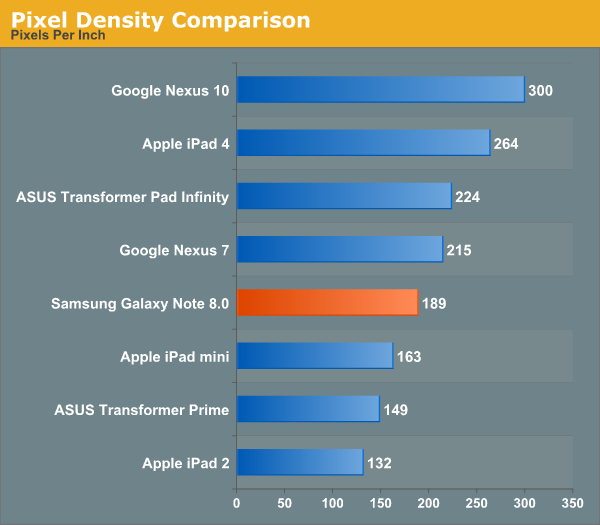
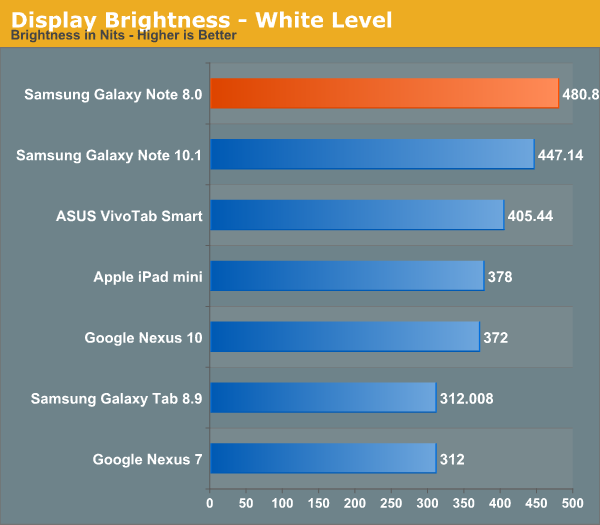
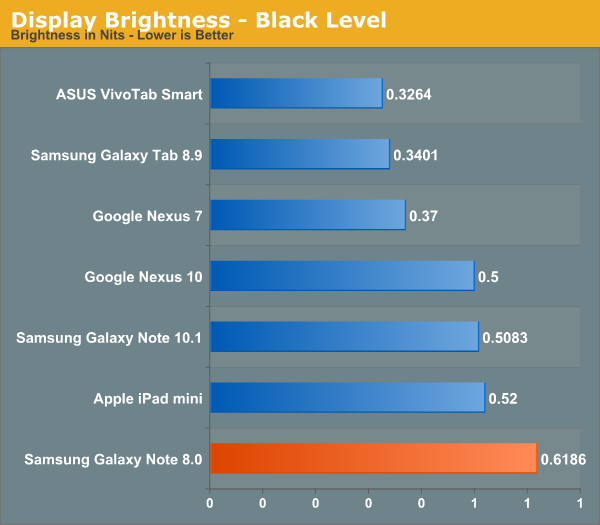
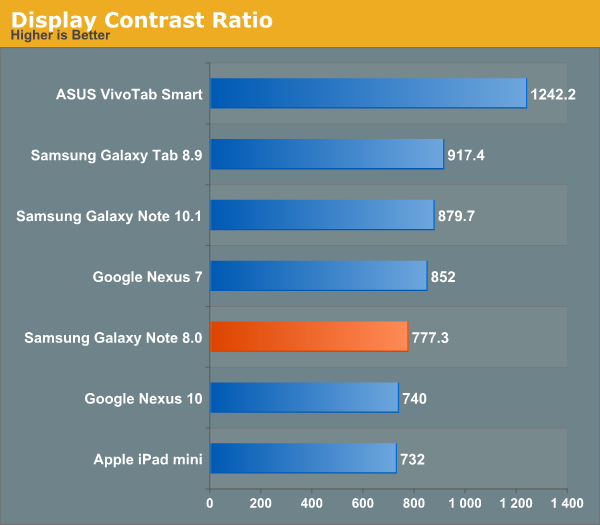
The Galaxy Note 8.0 uses a standard LED backlit LCD display instead of the AMOLED based panels common in Samsung’s smartphones. The departure is a welcome change in my opinion as the Note 8’s avoids Samsung’s AMOLED color calibration tendencies. In fact, the Galaxy Note 8.0’s display performed very similarly to the iPad mini in our color accuracy tests:
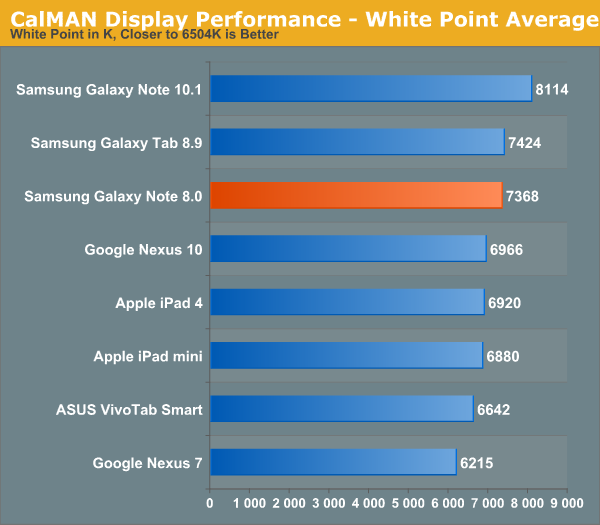
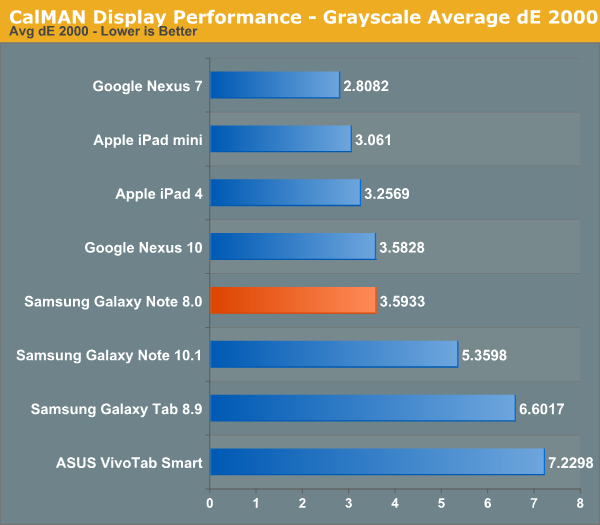

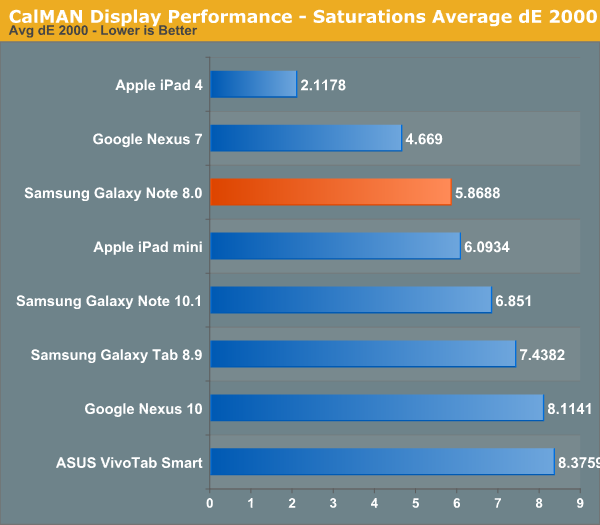

The mini doesn’t feature as accurate of a display as the bigger Retina iPads, which gives the Note 8 a lower target to shoot for, but its performance is admirable nonetheless.
Samsung does offer a couple of display presets on the Note 8, similar to what it does on other platforms. Choosing between Dynamic, Standard and Movie modes plays around with white points and color balance a bit. The standard setting is pretty good out of the box, although movie mode does move the white point closer to 6500K and improved color accuracy by a little bit.
The Note 8’s software build also ships with support for a reader mode that further warms up the white point in an attempt to make reading text easier on your eyes. In an attempt to bring as much of the PC experience as possible to Android tablets, Samsung bombards you with customization options - including the ability to select which applications use reader mode when it’s enabled. You can’t enable reader mode for all apps, but 3rd party apps are supported.


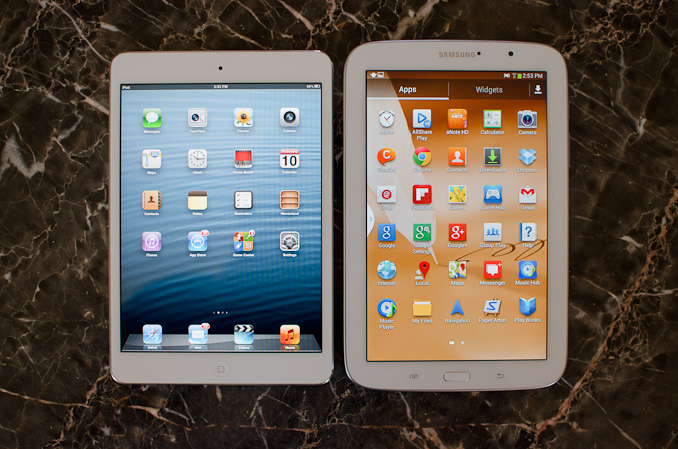











95 Comments
View All Comments
herts_joatmon - Friday, April 19, 2013 - link
You could always root this, under clock and undervolt the CPU thus giving you Nexus 7 level performance and improved battery life. I also assume that the Wacom digitizer tech used in this uses additional electricity meaning that if it was applied to the Nexus 7, you would probably get reduced battery life anywayHisDivineOrder - Thursday, April 18, 2013 - link
The reason Samsung is doing a sea of niches is because they've got the advantage of a huge manufacturing infrastructure they can rely on to do it and do it well. They intend to drown Apple in an ocean of different products at different sizes and specs, bombarding the consumer in so much product there's little chance they haven't made something better for you in an Android variety.Poor Apple. They aren't destined to win this one. They're going to be shoved back into that niche box by the end and a big part of the reason will be Samsung, their ex-partner they burned with lawsuits and price bickering. Another large part of the reason will be the fact that Apple seems to be tapped out on new ideas or innovative styling.
Now everything's just, "Thinner, silverer, black/white-er." They're like fans of a dead man who can't appreciate anything new because of a blind devotion to the rapidly decaying chic of the dearly departed.
nerd1 - Friday, April 19, 2013 - link
Samsung has some advantage over other OEMs, but not over apple. BOM of apple products are always much cheaper, and they are enjoying double the margin of others.Mercadian - Thursday, April 18, 2013 - link
Hi Anand,Why have you stopped benchmarking mobile SoCs with Epic Citadel? I remember you did a great job with iPhone 4S review.
Jumangi - Thursday, April 18, 2013 - link
I don't know why Samsung thinks this thing is worth $400. I'm not the biggest Apple fan but at that price I would just buy the iPad.herts_joatmon - Friday, April 19, 2013 - link
Look up the price of a wacom tablet. then add that price to the iPad to get a comparable price. This is a modern tablet and graphics tablet in one The ipad is just a modern tablet.nerd1 - Friday, April 19, 2013 - link
iPad users are actually paying $100 to get JOT stylus to get a half-baked pressure sensitivity...SuperSuperChicken - Friday, April 19, 2013 - link
"If you’re the type of person to value, polish and take care of the things you own, the Note 8’s construction doesn’t convey luxury. If you want something you’re not going to feel bad about tossing about like you would your keys or a bag, maybe a plastic tablet is less of a problem."I see this a lot on Anandtech lately, with the phone reviews and now this. The insinuation is that if I don't want a metal-cased device, then automatically I'm one that doesn't care about the condition of my devices or how they look, which is simply not true.
Now, I'm no fan of glossy plastic, I would have hoped the manufacturers would have moved away from it by now. However, I am a fan of plastic and prefer it over metal devices such as the iPad due to the fact that in the real world, I can actually hold onto a plastic device whereas the metal ones tend to slip through my fingers. I think the Nexus 7 is a nice looking device, but even I'm not foolish enough to argue that it looks better than the iPad. However, when I have to encase the iPad in a cover in order to be able to hold it, it seems the point is moot.
I appreciate quality materials, however, in my case it doesn't take precedence over practicality. With plastic bodies, I can run my phone and tablet without cases, keeping them slim as designed - which is something metal bodied devices wouldn't be able to offer. I just ask that you keep that perspective in mind and don't just assume that everyone who has a plastic-bodied device doesn't care how it looks and is want to mistreat them.
nerd1 - Friday, April 19, 2013 - link
I see lots of plastic cases for metal phones - I wonder why nobody makes a metal case for plastic phones.SuperSuperChicken - Friday, April 19, 2013 - link
Companies do, actually (search for "metal case galaxy s3"). I'm not sure how much I'd trust them not to degrade reception though.